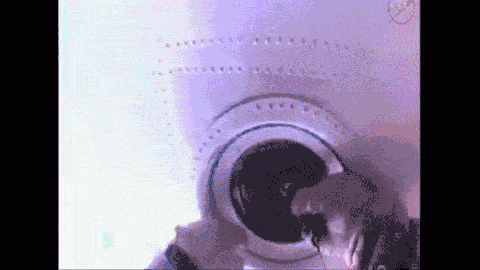Your house windows need much more cleaning than the windows on the International Space Station (ISS). There’s simply not enough stuff in space to dirty the windows that much. But there is some stuff still.
Micrometeoroid and orbital debris impacts leave behind tiny residues and scratches, gradually reducing visibility. Thruster firings from visiting spacecraft also release exhaust particles that settle on the station’s exterior, including the windows. Additionally, outgassing from materials on the ISS and payloads can deposit thin films of contaminants over time. Space isn’t exactly the pristine vacuum we often consider it. As a result, the ISS windows need cleaning; rarely, but they need it.
But how do you wash windows in space?

Cleaning the ISS windows is no simple task. It’s not like astronauts can lean out with a squeegee and spray some Windex. The process must be carefully planned to ensure safety and effectiveness.
In 2015, Russian cosmonauts Mikhail Kornienko and Gennady Padalka took a five-and-a-half-hour spacewalk to scrub the windows and perform additional maintenance tasks. Granted, the two cosmonauts completed two other tasks during this time: they retrieved an old experiment which measured how superheated gas from space affected the ISS hull and also cut loose an old communication antenna. All in a day’s work for the ISS.
They used non-abrasive cloths and specially designed wipes to remove grime. Unlike on Earth, where gravity helps with cleaning, every motion in space must be deliberate to prevent floating debris. They couldn’t use water because in microgravity, liquid doesn’t behave the way it does on Earth. Water droplets would float away and could potentially short-circuit equipment. Instead, astronauts use dry wipes or special solvents designed to work in vacuum conditions.
Inside the station, astronauts clean windows more regularly—though not as dramatically as during spacewalks. Alcohol-based wipes are the go-to method, used to remove fingerprints, condensation, and dust that accumulates from daily life inside the ISS.
To minimize the need for cleaning, astronauts are careful when handling food and fluids near the cupola. Since liquids behave unpredictably in microgravity, a spilled drink can lead to tiny droplets floating toward the windows, requiring careful cleanup.
According to NASA’s “Space Hygiene” podcast, astronauts aboard the International Space Station (ISS) use disinfectant wipes to clean various surfaces, including handrails, handheld microphones, and computers, to minimize bacterial contamination. These wipes are essential for maintaining hygiene in the microgravity environment of the ISS.
So, the next time you clean your windows at home, consider this: at least you don’t have to suit up, depressurize an airlock, and spend hours floating in microgravity just to get the job done.
This article was originally published in 2015 and has been re-edited.


